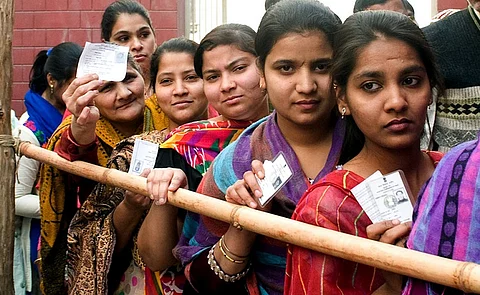

The Election Commission is setting up special Sakhi, or Pink, polling booths in the upcoming Karnataka Assembly Elections. These special booths will be staffed entirely by women – from the presiding officers to the micro-observers and security personnel.This is being done to attract more women to vote.
Gender Studies scholars and political analysts have hailed this move, saying that it would encourage more women to come out and vote.
The state plans to have at least 450 such booths across the state. The booths will be decorated with pink balloons, tablecloths, walls, etc., and the officials will all be dressed in shades of pink.
“With so many Director Generals demanding for such a booth in their areas, we suspect there will be around 450 booths in all. We will ensure these booths come up in areas where 60% of the women are registered as voters. We have taken many measures to ensure women vote. Under the SVEEP (Systematic Voters’ Education and Electoral Participation) programme, TV spots are being released for advertisements. Radio shows, dramas, plays, etc., are being organised too,” an electoral officer told TNM.
Pink polling booths were seen in the Assembly polls held in Punjab, Goa, Himachal Pradesh, Gujarat and some northeastern states.
Scholars working in the field of Women’s Studies and electoral practices have appreciated the move. Speaking with TNM, Pratikshya Priyadarshini, a Women’s Studies scholar said, “Inherent power relations are present in all aspects and public spaces. In a patriarchal society like India, men hold the positions of authority and women find it difficult to approach them, especially if they are strangers. Women will feel safer in a space where there are more women and will find it easier to clarify doubts. There have been cases where election officials have taken the voters' hand and taught them how to use the EVM. This is a deterrent for women voters, especially from rural areas. Women will feel more comfortable if there are female officials too.”
Praveen Rai, a political analyst working in the field of survey research and election studies called this move a gender-sensitive step that will provide a sense of security for women. Speaking to TNM, he said, “Patriarchy has been one of the reasons for women’s turnout being lower than men, but the divide is coming down with every passing elections.”
Scholars have also asked for better transportation facilities, especially in far-flung areas, to encourage women to come out and exercise their franchise.
For the 2018 Karnataka Assembly elections, there are around 4.97 crore registered voters, up by 12% from the 4.37 crore voters registered in 2013. There are 2.52 crore male voters this time, compared to the 2.23 crore registered in 2013.
From 2.13 crore in 2013, the number women voters registered have increased by 14.53%, to 2.44 crore for the upcoming elections.
In Mysuru’s 11 constituencies, almost 50% of all voters are women. Similarly, in some constituencies of Bengaluru, like Sarvagnanagar, Jayanagar and Rajajinagar, there are almost an equal number of male and female voters.
In the 2013 Karnataka assembly elections, the overall voting percentage was 71.45%, a sharp increase from 64.78% in 2008. Bengaluru, infamous for low its voter participation, had recorded 57.38% voting, up from 49.87% in 2008.
In fact, all districts, except Mysuru, had improved voter turnout compared to 2008. What is interesting to note here is the male-female ratio. In 2013, the male voting percentage was 72.4% (compared to 66.33% in 2008) and female voting percentage was 70.47% (compared to 63.23% in 2008).
In the 2014 Lok Sabha elections, Karnataka had its third-highest voter participation in a parliamentary election at 67.28%. In that election, the turnout of women voters at 65.81% was the highest-ever in a parliamentary poll in the state. The difference between the overall percentage and women percentage, 1.47% in that case, has been shrinking over the years. It was 2.16% in the 2009 Lok Sabha polls.
Even with more women participating in the electoral process, the numbers of women candidates and representatives in our elected bodies remains abysmally low. In the present Karnataka Assembly, there are only 6 women representatives out of the total 224. There are only 11.8% women members (64 out of 543) in the Lok Sabha and 11% women members (27 out of 245) in the Rajya Sabha. Praveen Rai said, “Providing more seats to women would be the biggest driver for achieving gender equality in the electoral process, which is missing in India.”